Linux如何启动并装载程序
理解编译链接的过程和ELF可执行文件格式

第一步:先编辑一个hello.c
第二步:生成预处理文件hello.cpp
gcc -E -o hello.cpp hello.c -m32
vi hello.cpp (
第三步:编译成汇编代码hello.s
gcc -x cpp-output -S -o hello.s hello.cpp -m32
vi hello.s
第四步:编译成目标代码,得到二进制文件hello.o,
gcc -x assembler -c hello.s -o hello.o -m32
vi hello.o
第五步:链接成可执行文件hello,
gcc -o hello hello.o -m32
vi hello
第六步:运行一下
./hello
gcc -o hello hello.c
gcc -o hello.static hello.o -m32 -static
hello.static 也是ELF格式文件
运行一下hello.static
./hello.static
ELF三种主要的目标文件:
ELF文件格式是一个开放标准,各种UNIX系统的可执行文件都采用ELF格式,它有三种不同的类型:
可重定位的目标文件(Relocatable,或者Object File):保存代码和适当数据,和其它Object文件一起创建可执行文件或共享文件。
可执行文件(Executable):文件保存一个用来执行的程序,该文件指出exec如何来程序进程映像。
共享库(Shared Object,或者Shared Library):保存代码和合适的数据,用来被连接编辑器和动态链接器进行链接。
ELF目标文件参与程序的链接和执行。ELF头文件里保存了文件的组织情况,告诉系统如何创建一个进程的内存映象。
当通过用父进程调用fork创建一个新进程时,系统实际上是拷贝了父进程的一个文件段和虚拟了一个内存段。虚拟内存是假想的内存,它其实是不存在的,而仅仅是由一些硬件和软件管理的一种“系统”。他提供了三个重要的能力:1,它将主存看成一个存储在磁盘上的地址空间的高速缓存,在主存中只保存活动区域,并根据需要在磁盘和主存之间来回传送数据(这里存在“交换空间”以及“页面调度”等概念),通过这种方式,高效地利用主存;2,它为每个进程提供了统一的地址空间(以虚拟地址编址),从而简化了存储器管理;3,操作系统会为每个进程提供独立的地址空间,从而保护了每个进程的地址空间不被其他进程破坏。
静态链接的ELF可执行文件与进程的地址空间:
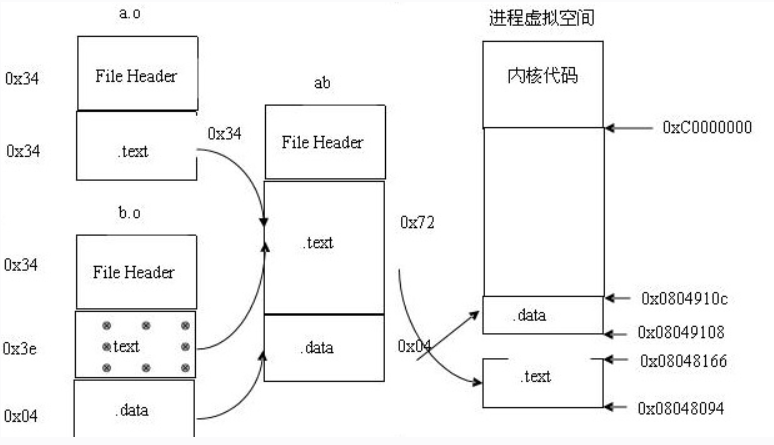
ELF的格式如下:

装载可执行文件
LINUX 一般通过shell程序为执行环境来启动一个可执行程序。Shell本身不限制命令行参数的个数,它受限于命令自身;Shell会调用一个系统调用exece将命令参数和环境参数传递给可执行程序的main函数。
命令行参数与环境变量的保存与传递:
当fork一个子进程时,是先复制父进程,再调用exece,会把原来的进程环境覆盖掉,用户态堆栈也被清空。用户态堆栈以start_stack作为main函数的起点,把argv[ ]命令行参数 和envp[ ]环境变量的内容通过指针的方式传递到系统调用exeve(内核处理函数);exeve创建一个新的用户态堆栈时把上面的命令行参数与环境变量拷贝到新的用户态堆栈里,从而初始化新的可执行程序的上下文环境。exece在内核态下装载可执行程序,再返回用户态。所以它先进行函数调用参数传递,然后系统调用参数传递,最后又进行函数调用参数传递。
动态链接
动态链接是相对于共享对象而言的。动态链接器将程序所需要的所有共享库装载到进程的地址空间,并且将程序汇总所有为决议的符号绑定到相应的动态链接库(共享库)中,并进行重定位工作。
动态连接有两种形式:可执行程序装载时动态连接和运行时动态链接
实验过程
删除menu目录,git克隆一个新的menu目录,并使用test_exec.c覆盖test.c文件。
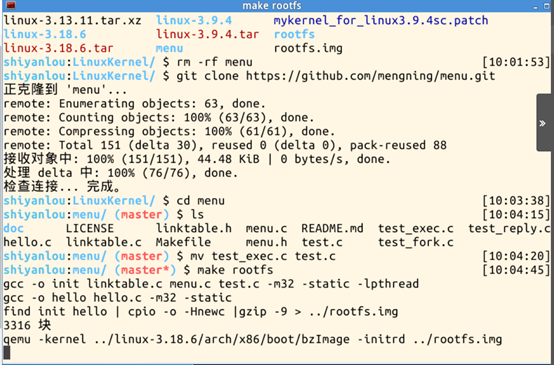
makerootfs,启动内核

关闭内核,重新执行qemu,并增加参数-s,-S冻结内核执行状态,打开gdb,连接端口1234
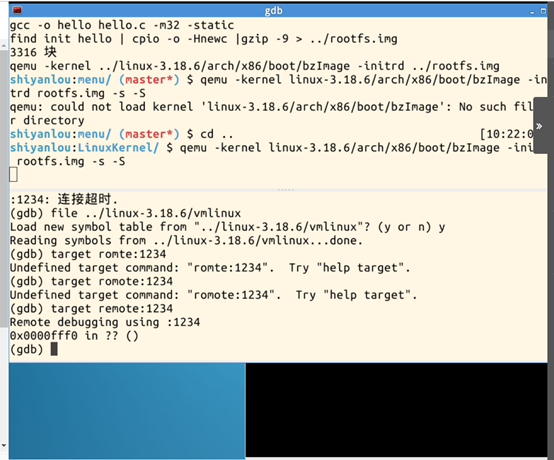
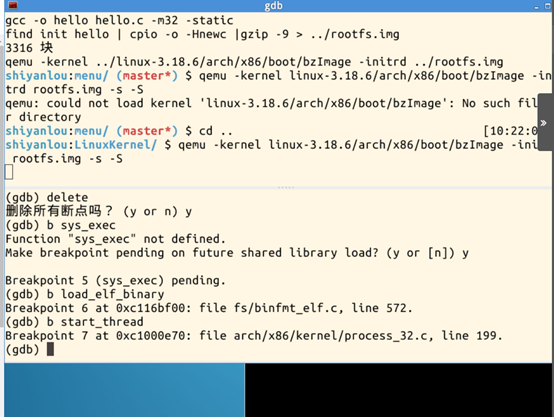
开始执行,在内核中执行exec命令,发现会卡住
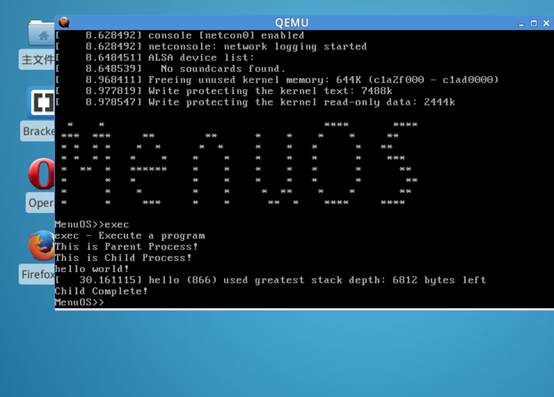
查看hello的EIF信息
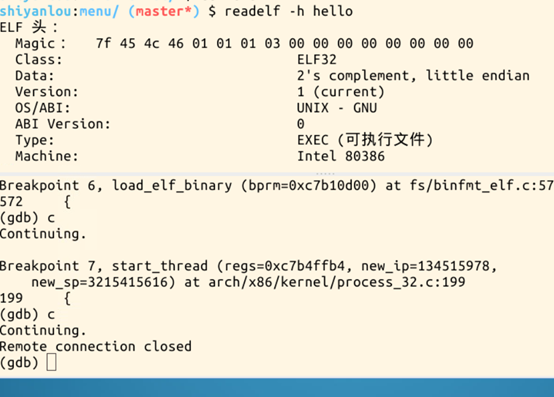
execve 处理过程:
linux/fs/exec.c
SYSCALL_DEFINE3(execve,
const char __user *, filename,
const char __user *const __user *, argv,
const char __user *const __user *, envp)
{
return do_execve(getname(filename), argv, envp);
}
int do_execve(struct filename *filename,
const char __user *const __user *__argv,
const char __user *const __user *__envp) //__user 用户态指针
{
struct user_arg_ptr argv = { .ptr.native = __argv };//命令行参数变成结构
struct user_arg_ptr envp = { .ptr.native = __envp };
return do_execve_common(filename, argv, envp);
}
static int do_execve_common(struct filename *filename,
struct user_arg_ptr argv,
struct user_arg_ptr envp){
struct linux_binprm *bprm; //保存要执行的文件相关的信息(include/linux/binfmts.h)
...
file = do_open_exec(filename);//打开执行的可执行文件
//填充bprm结构
bprm->file = file;
bprm->filename = bprm->interp = filename->name;
...
retval = copy_strings(bprm->argc, argv, bprm);//命令行参数和环境变量copy到结构体里
retval = exec_binprm(bprm);//
}
static int exec_binprm(struct linux_binprm *bprm)
{
pid_t old_pid, old_vpid;
int ret;
/* Need to fetch pid before load_binary changes it */
old_pid = current->pid;
rcu_read_lock();
old_vpid = task_pid_nr_ns(current, task_active_pid_ns(current->parent));
rcu_read_unlock();
ret = search_binary_handler(bprm);//寻找可执行文件的处理函数
if (ret >= 0) {
audit_bprm(bprm);
trace_sched_process_exec(current, old_pid, bprm);
ptrace_event(PTRACE_EVENT_EXEC, old_vpid);
proc_exec_connector(current);
}
return ret;
}
/*
* cycle the list of binary formats handler, until one recognizes the image
*/
int search_binary_handler(struct linux_binprm *bprm)
{
struct linux_binfmt *fmt;
...
//循环寻找能够解析当前可执行文件的代码
list_for_each_entry(fmt, &formats, lh) {
if (!try_module_get(fmt->module))
continue;
read_unlock(&binfmt_lock);
bprm->recursion_depth++;
retval = fmt->load_binary(bprm);//加载可执行文件的处理函数,函数指针,实际调用load_elf_binary(linux/fs/binfmt_elf.c)
read_lock(&binfmt_lock);
put_binfmt(fmt);
bprm->recursion_depth--;
if (retval < 0 && !bprm->mm) {
/* we got to flush_old_exec() and failed after it */
read_unlock(&binfmt_lock);
force_sigsegv(SIGSEGV, current);
return retval;
}
if (retval != -ENOEXEC || !bprm->file) {
read_unlock(&binfmt_lock);
return retval;
}
}
read_unlock(&binfmt_lock);
}